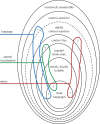Principles of structure building in music, language and animal song
- PMID: 25646520
- PMCID: PMC4321138
- DOI: 10.1098/rstb.2014.0097
Principles of structure building in music, language and animal song
Abstract
Human language, music and a variety of animal vocalizations constitute ways of sonic communication that exhibit remarkable structural complexity. While the complexities of language and possible parallels in animal communication have been discussed intensively, reflections on the complexity of music and animal song, and their comparisons, are underrepresented. In some ways, music and animal songs are more comparable to each other than to language as propositional semantics cannot be used as indicator of communicative success or wellformedness, and notions of grammaticality are less easily defined. This review brings together accounts of the principles of structure building in music and animal song. It relates them to corresponding models in formal language theory, the extended Chomsky hierarchy (CH), and their probabilistic counterparts. We further discuss common misunderstandings and shortcomings concerning the CH and suggest ways to move beyond. We discuss language, music and animal song in the context of their function and motivation and further integrate problems and issues that are less commonly addressed in the context of language, including continuous event spaces, features of sound and timbre, representation of temporality and interactions of multiple parallel feature streams. We discuss these aspects in the light of recent theoretical, cognitive, neuroscientific and modelling research in the domains of music, language and animal song.
Keywords: Chomsky hierarchy; animal vocalization; comparative perspective; computational modelling; language; music.
© 2015 The Author(s) Published by the Royal Society. All rights reserved.
Figures


 denote a change of key such that a new tonic region (TR) is instantiated from an overarching tonal context of the tonal function x in the key ykey.
denote a change of key such that a new tonic region (TR) is instantiated from an overarching tonal context of the tonal function x in the key ykey.

Similar articles
-
Music and animal song follow a mode of extra-genomic evolution similar to that of language.Phys Life Rev. 2025 Jul;53:141-143. doi: 10.1016/j.plrev.2025.02.009. Epub 2025 Feb 28. Phys Life Rev. 2025. PMID: 40058169
-
The evolution of human music in light of increased prosocial behavior: a new model.Phys Life Rev. 2024 Dec;51:114-228. doi: 10.1016/j.plrev.2023.11.016. Epub 2023 Dec 28. Phys Life Rev. 2024. PMID: 39426069 Review.
-
Isochrony as ancestral condition to call and song in a primate.Ann N Y Acad Sci. 2024 Jul;1537(1):41-50. doi: 10.1111/nyas.15151. Epub 2024 Jun 25. Ann N Y Acad Sci. 2024. PMID: 38925552
-
The biology and evolution of music: a comparative perspective.Cognition. 2006 May;100(1):173-215. doi: 10.1016/j.cognition.2005.11.009. Epub 2006 Jan 17. Cognition. 2006. PMID: 16412411 Review.
-
Temporal modulation in speech, music, and animal vocal communication: evidence of conserved function.Ann N Y Acad Sci. 2019 Oct;1453(1):99-113. doi: 10.1111/nyas.14228. Epub 2019 Sep 4. Ann N Y Acad Sci. 2019. PMID: 31482571 Review.
Cited by
-
Automatic Recognition of Element Classes and Boundaries in the Birdsong with Variable Sequences.PLoS One. 2016 Jul 21;11(7):e0159188. doi: 10.1371/journal.pone.0159188. eCollection 2016. PLoS One. 2016. PMID: 27442240 Free PMC article.
-
Understanding Design Features of Music and Language: The Choric/Dialogic Distinction.Front Psychol. 2022 Apr 22;13:786899. doi: 10.3389/fpsyg.2022.786899. eCollection 2022. Front Psychol. 2022. PMID: 35529579 Free PMC article.
-
Toward a Computational Neuroethology of Vocal Communication: From Bioacoustics to Neurophysiology, Emerging Tools and Future Directions.Front Behav Neurosci. 2021 Dec 20;15:811737. doi: 10.3389/fnbeh.2021.811737. eCollection 2021. Front Behav Neurosci. 2021. PMID: 34987365 Free PMC article. Review.
-
Unpredictability of the "when" influences prediction error processing of the "what" and "where".PLoS One. 2022 Feb 3;17(2):e0263373. doi: 10.1371/journal.pone.0263373. eCollection 2022. PLoS One. 2022. PMID: 35113946 Free PMC article.
-
The right inferior frontal gyrus processes nested non-local dependencies in music.Sci Rep. 2018 Feb 28;8(1):3822. doi: 10.1038/s41598-018-22144-9. Sci Rep. 2018. PMID: 29491454 Free PMC article.
References
-
- Hurford JR. 2011. The origins of grammar: language in the light of evolution II, vol. 2 Oxford, UK: Oxford University Press.
-
- Knörnschild M, Feifel M, Kalko EK. 2014. Male courtship displays and vocal communication in the polygynous bat Carollia perspicillata. Behaviour 151, 781–798. (10.1163/1568539X-00003171) - DOI
Publication types
MeSH terms
LinkOut - more resources
Full Text Sources
Other Literature Sources

